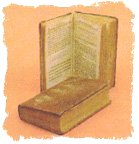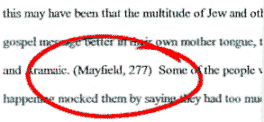Why do I need a bibliography page?
You need a bibliography page when . . .
- When you want to demonstrate that you did "due diligence" in terms of research, even if you do not use any direct quotes from sources you consulted.
- When you want me to know you did not concoct your paper
out of thin air or simply copy and paste it from the Internet. [ SNU's statement on plagiarism ]
- When you want your work to look professional. A bibliography page strengthens the credibility of your writing (That means it can improve your grade!).

Use a bibliography page to tell me . . .
- 1. You actually did some research.
- A bibliography page helps your work pass the "baloney detector" test. A list of sources affirms that you did not make up key facts and supporting quotes.
- 2. You checked more than one source.
- Can what you wrote be corroborated? That is, did you consult more than one source?
Confirmability is an important test of truth. The number of entries is not the only test of a good
bibliography. However, a bibliography listing several sources usually indicates that you have
"triangulated" your information. That means you found at least two other sources
that support the data you originally found.
- 3. You know who wrote your sources.
- What about the authors' credentials? Are they trustworthy names? Will I see the names of people known for engaging the subject thoughtfully? Will I know them as people concerned with truth?
- 4. You know who published your sources.
- Is the publisher a more believable source than supermarket tabloids (as exciting as those can be)?
- 5. You know when your sources were published.
- How old is your information? Copyright dates in bibliography entries have a certain
importance. Is it likely to be considered correct today? Old is not bad.
Old does not mean it has no value. Original source documents can be very important.
However, a classic text on Biblical archaeology written in 1895 will not have information on
discoveries of the last 125 years. Balance the use of older sources with some new ones. This will also give you confirming "triangulation."
You can tell me all these things by including a proper bibliography page at the end of
what you've written. On the other hand, . . . . a paper lacking a bibliography page may lead
me to think one of two things (neither of which would be good for your grade):
- You made up everything
- You copied from one source and do not want me to know that.
Want to know how to make a bibliography page?
If you did any research at all, give me a listing of your sources on a separate bibliography
page. Use MLA format for those listings.
Sample bibliography entries
Use these actual student entries as a pattern for constructing your bibliography.
Taken from a student paper for Introduction to Biblical Literature at Southern
Nazarene University
Broadman & Holman Reference. Holman Concise
Bible Dictionary. Wheaton, Illinois: Broadman & Holman Publishers, 1996.
Mayfield, Joseph H. and Ralph Earle, eds. Beacon Bible
Commentary. Kansas City, Missouri: Beacon Hill Press, 1965.
McGee, Vernon J. Thru the Bible. Volume IV. Nashville,
Tennessee: Thomas Nelson Publishers, 1976.
Nelson's Pocket Reference. Nelson's Pocket Bible
Dictionary. Nashville, Tennessee: Thomas Nelson Publishers, 1999
Tenney, Merrill C., ed. The Zondervan Pictorial Bible
Dictionary. Grand Rapids, Michigan: Zondervan Publishing House, 1967.
Documenting quotations and information
Many of your courses in school require you to submit written research reports. With
oral reports [ read more ] in
Introduction to Biblical Literature at
Southern Nazarene University, for example, students must still turn in a two- to three-page
paper.
In these research papers, you must document your sources for quotes as well as for factual
material. Rather than a traditional Turabian-style footnote at the bottom of a page, you may use
a format like the APA (American Psychological Association) style in which a brief reference
with the author's name and a page number is placed within the text of your paper.

Citing the Bible
English Bible versions vary in wording. Therefore, you need to make clear
which Bible version you're using (italicize or underline the version title),
followed by book (do not italicize or underline the book name), chapter, and verse.
For example: Ezekiel saw what seemed to be four living creatures,"each with faces of a man,
a lion, an ox, and an eagle" (New Jerusalem Bible, Ezekiel 1:5-10).
If you are using the same version for all Bible quotes, after the first reference, only give the
Bible book and chapter and verse numbers since you've established which edition of the Bible
you will be using. If you use different versions, then indicate which one is being used in each
citation.
Bibliography entries for the Bible
(be sure to indent the second and following lines of an entry):
The Jerusalem Bible. A. Jones, ed. Garden City, New York: Doubleday, 1966.
Judges. Holy Bible: New international version. Grand Rapids, Michigan: Zondervan, 1978.
The Bible: A new translation, James Moffatt, translator. New York: Harper and Row, 1954.
 Using MLA style formats:
How to write papers following Modern
Language Association guidelines
Using MLA style formats:
How to write papers following Modern
Language Association guidelines
Additional writing help for you
Five Reasons to Create a Bibliography Page?
Bibliography pages serve several important purposes in academic writing and research:
- Credibility and Verification: A bibliography
provides a list of sources consulted or referenced in the work. By including a bibliography,
you demonstrate that your work is well-researched and supported by credible sources.
Readers can verify the information presented and assess the reliability of your claims.
- Acknowledgment of Sources: Bibliographies give
credit to the authors or creators of works that have been consulted or cited. Properly citing sources helps avoid plagiarizing. It also shows respect for intellectual property rights.
- Further Reading: A bibliography can also serve as a resource for readers who wish to investigate the topic further. It provides a curated list of
additional readings. That helps interested individuals to dig deeper into the subject matter.
- Contextual Information: In some cases, the bibliography may include annotations or brief descriptions of the sources. This additional
information can help readers understand the relevance of each source to the topic at hand and its value to their own research.
- Scholarly Communication: In academic and research settings, bibliographies help scholarly communication. They allow researchers to trace the
lineage of ideas and build upon existing knowledge. By referencing previous works, authors can situate their contributions within broader academic discussions.
In short, bibliography pages are important in academic writing. They are a foundation for transparency, accountability, and the dissemination of knowledge.
-- Howard Culbertson, hculbert@gmail.com
Here is help for doing well in your classes



 Using MLA style formats:
How to write papers following Modern
Language Association guidelines
Using MLA style formats:
How to write papers following Modern
Language Association guidelines